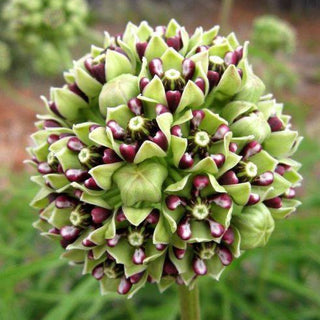SPIDER ANTELOPE HORNS MILKWEED
Asclepias viridis
- Unit price
- / per
Description
Unlike many other Milkweed, Spider Milkweed (also known as Antelope Horns Milkweed) is a medium-height Milkweed, which can make it easier to fit into a small space, or an up-front garden. Flowers are quite large, extremely attractive, and creamy white with burgundy highlights. Plants will slowly spread in the garden, and are very tolerant of dry conditions.
The milkweed flowers attract MANY butterflies of all kinds (not just Monarchs)! The beautiful perfume of the flowers is fragrant for quite a distance away, which draws butterflies of all kinds to it's nectar!
Milkweed is an essential perennial plant for the butterfly garden, and it is the ONLY plant that the monarch caterpillar can eat! It is probably the most used plant 'food' (nectar) for pollinators. Our milkweed have monarch caterpillars on it almost every year. Look carefully under the leaves, which is where they are usually hiding. If they are present on your plant, they will often make their chrysalis there too, and you can watch them transform from caterpillar to butterfly! Monarch butterflies are in steady decline, and habitat destruction is at least partially to blame. This plant can assist the monarch in recovering. Watching the life cycle of monarchs can be an excellent learning experience for kids too!
Type: Hardy perennial
Hardiness zones: 4-9
Height: 14"
Location: Sun or part sun
Bloom time: Mid summer to fall
Seeds per pack: 10 (previously 5)
Note: Ornamental use only. These seeds and/or plants are poisonous.
Germination: Start these seeds right away to preserve viability, no matter the time of year. Sow the seeds just under the surface of a sterile seed-start mix, and water in. Then cover them with plastic and place in a fridge for 5-6 weeks. Be sure they stay moist. After the cold stratification period they are then brought back to room temperature for them to germinate. Germination is generally within 60 days after the warming period, though they could take a few months. If possible, the best location for sowing in March, April and May, is in cold frame or a cold greenhouse where they will receive the cold period and fluctuating temperatures naturally.
SPIDER ANTELOPE HORNS MILKWEED
Asclepias viridis
- Unit price
- / per
Adding product to your cart
You may also like
Description
Unlike many other Milkweed, Spider Milkweed (also known as Antelope Horns Milkweed) is a medium-height Milkweed, which can make it easier to fit into a small space, or an up-front garden. Flowers are quite large, extremely attractive, and creamy white with burgundy highlights. Plants will slowly spread in the garden, and are very tolerant of dry conditions.
The milkweed flowers attract MANY butterflies of all kinds (not just Monarchs)! The beautiful perfume of the flowers is fragrant for quite a distance away, which draws butterflies of all kinds to it's nectar!
Milkweed is an essential perennial plant for the butterfly garden, and it is the ONLY plant that the monarch caterpillar can eat! It is probably the most used plant 'food' (nectar) for pollinators. Our milkweed have monarch caterpillars on it almost every year. Look carefully under the leaves, which is where they are usually hiding. If they are present on your plant, they will often make their chrysalis there too, and you can watch them transform from caterpillar to butterfly! Monarch butterflies are in steady decline, and habitat destruction is at least partially to blame. This plant can assist the monarch in recovering. Watching the life cycle of monarchs can be an excellent learning experience for kids too!
Type: Hardy perennial
Hardiness zones: 4-9
Height: 14"
Location: Sun or part sun
Bloom time: Mid summer to fall
Seeds per pack: 10 (previously 5)
Note: Ornamental use only. These seeds and/or plants are poisonous.
Germination: Start these seeds right away to preserve viability, no matter the time of year. Sow the seeds just under the surface of a sterile seed-start mix, and water in. Then cover them with plastic and place in a fridge for 5-6 weeks. Be sure they stay moist. After the cold stratification period they are then brought back to room temperature for them to germinate. Germination is generally within 60 days after the warming period, though they could take a few months. If possible, the best location for sowing in March, April and May, is in cold frame or a cold greenhouse where they will receive the cold period and fluctuating temperatures naturally.
You may also like
You may also like
Recommended Products
CUSTOMERS ARE ALSO BUYING THESE
We carry a diverse selection seeds from around the world, many are rare and hard to find!
Regular new seed stock, special cold/dry storage facility, and record keeping ensures our stock is fresh and ready to grow for you.
When you sign up, you are agreeing to receive promotional emails and other marketing communications from us. In the future, you can always unsubscribe.



